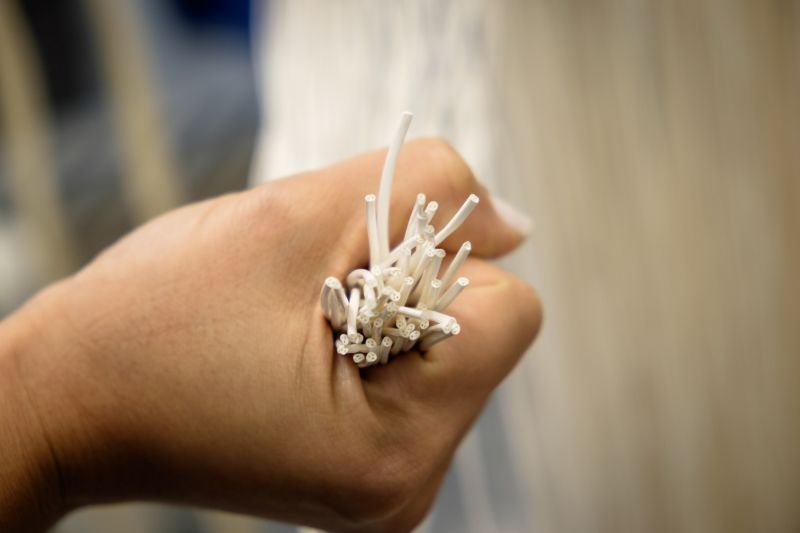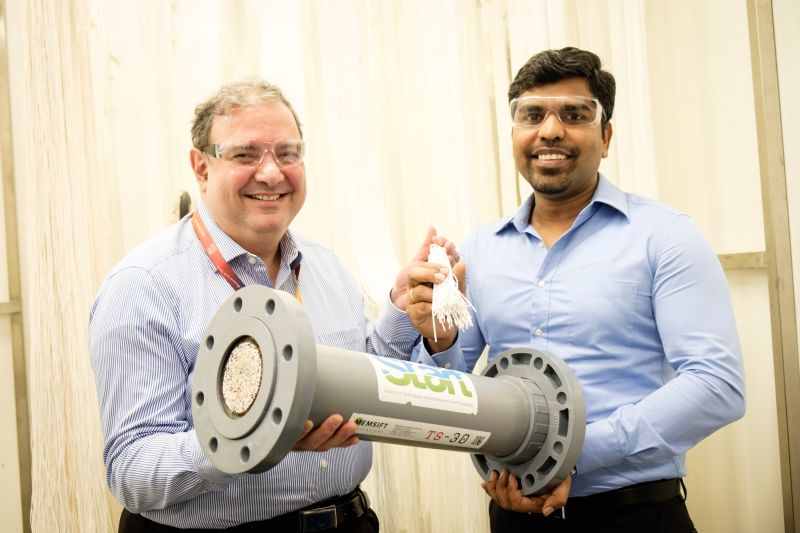New Membrane Water Treatment System to Reduce Toxic Waste and Waste Disposal Cost by Over 90%
Published on by Water Network Research, Official research team of The Water Network in Technology
A new pilot plant to treat industrial wastewater is being built that could potentially reduce the amount of liquid waste by over 90 percent .
In addition, the new plant which will be located at a semiconductor company in Singapore can also recover precious metals from the treated water which can then be sold and reused.

Close up of the tri-bore hollow-fibre membrane commercialised jointly by START Centre and Memsift Innovations
The plant is being built jointly by the Separation Technologies Applied Research and Translation ( START ) Centre, a national-level facility to develop and commercialize innovative separation and filtration technologies, and Memsift Innovations Pte Ltd, a local water technology firm specializing in zero-liquid discharge water treatment systems.
The START Centre is supported by the Singapore Economic Development Board (EDB) and Nanyang Technological University Singapore (NTU Singapore). It is part of NTUitive, the innovation and enterprise company of NTU Singapore.
The pilot plant uses a novel water treatment system that leverages a new type of hollow-fibre membrane invented by Professor Neal Chung at the National University of Singapore, which has been assigned to and scaled up for industrial application by the START Centre.
Unlike the typical hollow-fibre membrane, which resembles noodles with a hollow core like a straw, the new tri-bore hollow-fibre membrane invented by Prof Chung has three hollow cores, allowing for a water flow rate which is about 30 per cent higher.
Under a new research partnership and licensing agreement, START Centre and Memsift Innovations will jointly build the wastewater treatment plant with the tri-bore hollow-fibre membranes, which can treat up to 5,000 liters per day for a semiconductor firm.
This pilot plant is expected to help the firm save up to 1.6 million liters of water a year (2/3 of an Olympic-sized swimming pool), resulting in a savings of $250,000 in disposal cost. It will filter over 90 percent of wastewater into clean water and concentrate the metal waste into a liquid, which can then be sold to other companies.
The current solution practiced by the semiconductor factory is to transport the toxic wastewater produced during their manufacturing to a wastewater disposal facility where it is incinerated. This disposal process uses five times the energy cost of the pilot membrane filtration plant.
%20Dr%20Adil%20Dhalla,%20MD%20of%20START%20Centre%20holding%20the%20tri-bore%20hollow-fibre%20membrane%20with%20Dr%20Antony%20Prince%20(right),%20Founder%20of%20Memsift%20Innovations.jpg)
(Left) Dr Adil Dhalla, MD of START Centre holding the tri-bore hollow-fibre membrane with Dr Antony Prince (right), Founder of Memsift Innovations
Dr Adil Minoo Dhalla, Managing Director of START Centre, said this is the first successful licensing agreement achieved by the national-level center since it started in 2016, which seeks to turn cutting-edge membrane research from Singapore’s universities into real products usable by multinational and local companies.
“This pilot plant marks the first of many local water innovations which START is translating for commercialization. Using our cutting-edge membrane fabrication, module design and testing facilities, we are able to scale up novel technologies from Singapore’s institutes of higher learning rapidly and to test them in real-life environments to validate their commercial value,” added Dr Dhalla.
Dr Dhalla is the Chief Operating Officer of NTU’s Nanyang Environmental and Water Research Institute (NEWRI), and the Chair of the Steering Committee of SG-MEM, Singapore’s National Membrane Consortium supported by the National Research Foundation (NRF).
The consortium’s key institutional members include START Centre, which is the lead body, NEWRI’s Singapore Membrane Technology Centre at NTU, Membrane Science and Technology Consortium (MSTC) at NUS, and Environment and Water Technology Centre of Innovation (EWTCoI) at Ngee Ann Polytechnic.
The SG-MEM consortium, which was launched in 2018, already has 24 industry members (one of which is Memsift Innovations) from across Singapore’s membrane eco-system.
Dr J Antony Prince, Founder of Memsift Innovations, believes that the novel tri-bore hollow-fibre membrane from START Centre will help to improve the efficiency of their patent-pending thermal separation process, which provides unique benefits over traditional brine treatment and zero-liquid discharge solutions.
“Our filtration process operates at relatively low pressures and temperatures as compared to the conventional thermal-based separation processes. It saves energy, reduces operational cost, recovers precious metal and resources while helping to save the environment,” explains Dr Prince.
Other advantages offered by Memsift Innovations include a very high water recovery at minimum energy consumption, a small footprint for the treatment plants and minimum capital outlay for their clients.
This new pilot plant by START Centre and Memsift Innovations is expected to be commissioned in the second quarter of 2019. They will use the piloting results for the commercialization of this innovative technology.
It will demonstrate a step towards the concept of a circular economy – where waste is turned into resources while recycling water for industrial purposes, reducing the need to draw on fresh water from the PUB network. This helps Singapore to conserve its supply of clean water produced through the Four National Taps strategy.
If the pilot tests are successful, Memsift will obtain a full license from intuitive and commercialize it together with its proprietary solutions. The technology will be made available to other SG-MEM consortium members for commercial collaborations.
Material provided by Memsift Innovations Pte Ltd.
Media
Taxonomy
- Treatment
- Liquid Waste Treatment
- Industrial Wastewater Treatment
- Membrane Bioreactor Systems
- Waste Water Treatments
- Membranes
- Wastewater Treatment
- Polymeric Membranes
- Zero Discharge
- Membrane Technology
- Membrane Filtration
- Zero Liquid Discharge
- Water
- Waste Management
- UF membranes/cassettes for waste water treatment MBR
- Membrane distillation